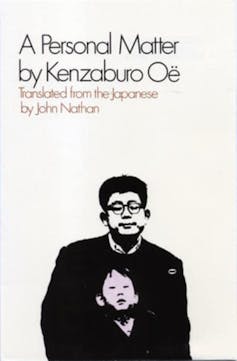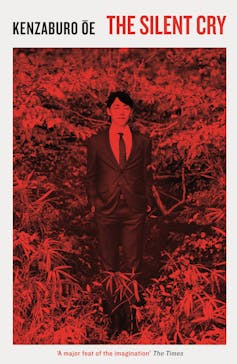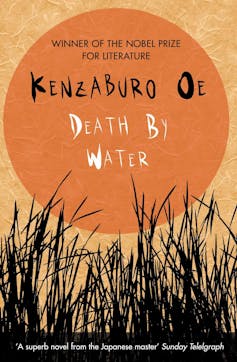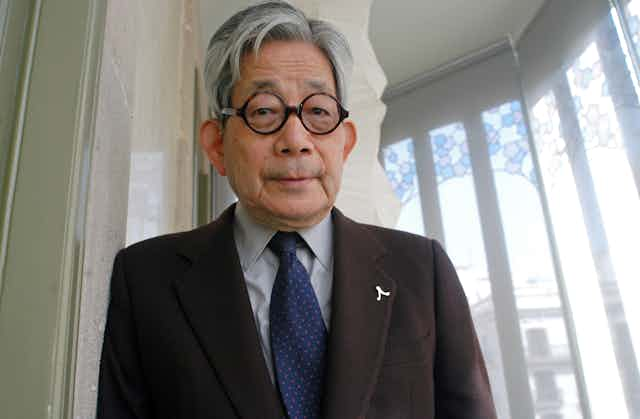Kenzaburō Ōe, the last of Japan’s great post second world war Japanese writers, died in early March. When he was awarded the Nobel prize in 1994, he said that as a novelist he wished to “enable both those who express themselves with words and their readers to recover from their own sufferings and the sufferings of their time, and to cure their souls of the wounds”.
He wrote on taboo themes in Japan such as disability through his life with his son Hikari, who was born with a herniated brain, autism and epilepsy. He wrote about the dangers of nuclear weapons and the aftermath of Hiroshima and about the communities and folklore of his native rural island Shikoku.
He portrayed human nature in all its aspects, even the most cruel, with great inventiveness. In the words of his English translator John Nathan, his works feature a “language all his own, a language which can accommodate the virulence of his imagination”.
Here is a list of five books to help you navigate Ōe’s writings.
1. A Personal Matter (1964)

Possibly the best known of Ōe’s novels, it follows the narrator “Bird” as he faces a personal crisis after his son is born with a brain herniation requiring immediate surgery. The novel explores, often with brutal sincerity, the conflict of a man unsure whether to let the child die or to coexist with it, thus giving up his dreams of an exotic life.
With this story (and in many others thereafter), Ōe breaks with the traditional Japanese form of the confessional, autobiographical I-novel. While inspired by his own son’s birth, Ōe distances himself from Bird and portrays the crisis of a man in connection with the universal theme of dealing with fatality and the inner demons it foregrounds.
2. Hiroshima Notes (1965)
In this essay collection, Ōe recounts his visits to Hiroshima beginning in the summer of 1963, when he was hired to write a report on a rally to abolish nuclear weapons. With his usual commitment to respecting human rights and suffering, the writer draws an often bleak portrait of how political factions appropriate victims’ traumas and subsume tragedy under political slogans.
Based on interviews with survivors, but also with the doctors and nurses who cared for them, Ōe’s accounts reveal the magnitude of the horrific bombing, which had long-lasting repercussions for decades after the events.
The question asked throughout is: “Did the Japanese really learn anything from the defeat of 1945?” Hiroshima Notes is a heartfelt cry to use the lessons of past mistakes to learn to respect human life, including the victims’ right to silence. Ōe’s opposition to nuclear weapons remained unwavering for all his life.
3. The Silent Cry (1967)

In this novel, which Ōe considered his most successful, two brothers return to their native village in Shikoku to sell their family home. There, their lives change as a result of revelations about repressed feelings and histories of violence, including present riots that echo the local uprisings which had involved their ancestors.
Through an elaborate structure, Ōe moves between three temporal planes, the turbulent years of peasant riots before the Meiji Restoration in 1868, the aftermath of Japan’s surrender in 1945 and the narrative present, reminiscent of the student protests of the 1960s. The rural setting uniting all of them is a mythical site where reality and local legends coalesce, offering a powerful reflection on the relationship between history, community, and memory.
4. The Changeling (2000)
This novel is the author’s attempt to come to terms with the death of his brother-in-law, the world-renowned film director Jūzō Itami, who allegedly died by suicide. In this semi-autobiographical narrative, Ōe’s fictional alter ego Kogito Chōkō enters in an asynchronous conversation with the tapes his brother in-law had recorded before his passing. Their discussions on art, life, and friendship make Kogito reflect on the possible causes of the suicide.
The Changeling proposes important reflections on how death affects those that are left behind. It is a moving tale about processing grief and of the possibilities for healing. It also includes possibly the most touching defence of education ever written.
5. Death by Water (2009)

Kogito Chōkō, now in his 70s, returns to his native Shikoku to finally write the novel about the truth of his father’s mysterious death at the end of the war. The fragmented recollections about the man, who had been involved with ultra-nationalistc reactionaries, motivate a critical reflection on the multiplicity of memory. Personal and local stories, intertwined with folklore, may appear in contrast with each other but they are nonetheless integral pieces of the complexity of human life.
Ōe’s novel, whose title is a reference to poet TS Eliot’s The Wasteland, examines how people have to live with traumatic events such as loss and rape, and also the preoccupation of an elderly father (Kogito/Ōe) about leaving his disabled son alone after his death.
Among the books in this list, female characters have the most prominent role here. Kogito’s wife, his sister and the young actress Unaiko all represent different generations and professions, eliciting considerations on the place of women in contemporary Japan.

